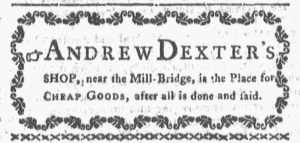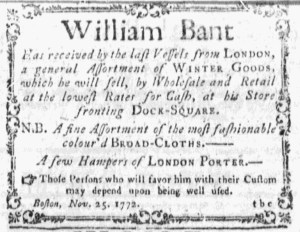What was advertised in a colonial American newspaper 250 years ago today?

“ANDREW DEXTER’S SHOP.”
Andrew Dexter’s advertisement in the November 30, 1772, edition of the Boston-Gazette consisted of only three lines, but its design likely gave it greater impact than other notices of similar length. A border comprised of ornamental type enclosed the entire advertisement, making the manicule that called attention to the first line an unnecessary addition. In its entirety, the advertisement stated, “ANDREW DEXTER’S SHOP, near the Mill-Bridge, is the Place for CHEAP GOODS, after all is done and said.”
Dexter had some experience using borders to set his advertisements apart from others in newspapers published in Boston. A lengthier advertisement that ran in the Boston Evening-Post, the Boston-Gazette, and the Massachusetts Gazette and Boston Weekly News-Letter in May featured a border. The border was not nearly as elaborate as the one in the advertisement published in November, but so few newspaper advertisements had borders that it still served its purpose.

The number of advertisers who opted for borders increased in the wake of examples that Jolley Allen, who had a long history with borders, and Dexter published in multiple newspapers in May. On the same day that Dexter’s brief notice with the prominent border ran in the Boston-Gazette, William Bant inserted advertisements with borders in both the Boston Evening-Post and the Boston-Gazette. Jonathan Williams, Jr., once again ran his advertisement enclosed within a border in the Massachusetts Gazette and Boston Post-Boy. Herman Brimmer and Andrew Brimmer had a border around just their names in an advertisement in the Supplement to the Boston Evening-Post. Later in the week, Bant and Williams ran advertisements enclosed within borders in the December 4 edition of the Massachusetts Gazette and Boston Weekly News-Letter. The Brimmers’ advertisement with a border around their names appeared in the supplement that accompanied that issue.
About half a dozen advertisers in Boston incorporated borders into their newspaper notices, publishing them so widely that they became a familiar to readers of several publications. The majority of advertisers did not adopt this strategy for distinguishing their notices from others, but enough did so to suggest that advertisers carefully observed the tactics deployed by their competitors, including decisions about graphic design, and planned accordingly for their own advertisements.









































































